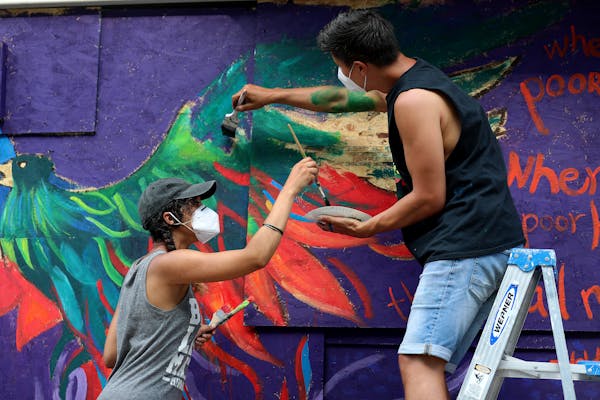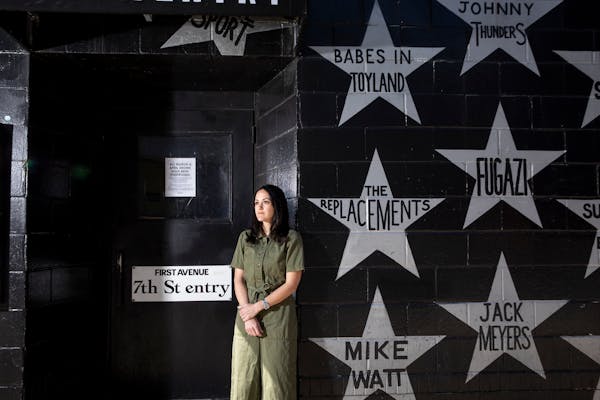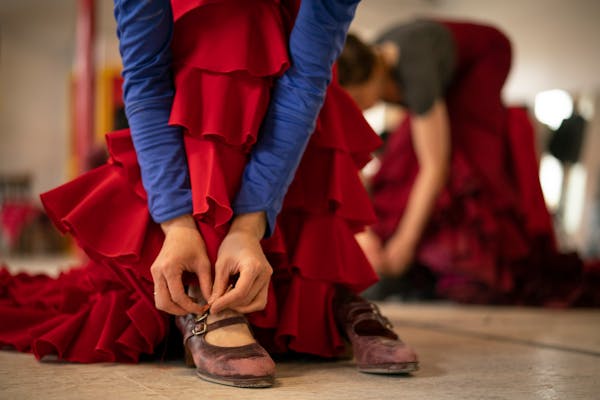
Shá Cage
When racial violence and injustice threatens to overwhelm a community, what can an artist do? What can a writer do? As actor, director and writer Shá Cage demonstrated this summer, they can do enormous things.
Following the death of George Floyd, Cage launched a new website, "A Moment of Silence: 50+ Black Minnesota Voices in a Historical Moment of Transformation." The online anthology features work by poets, playwrights, songwriters, novelists, memoirists and others who, the website states, "speak truth and resilience at a time when it is needed most."
Included are Tish Jones, Mary Moore Easter, Michael Kleber-Diggs, Andrea Jenkins, Marlon James. As it states on its home page, "We Are the Ones We Have Been Waiting For."
LAURIE HERTZEL

Nur-D
No musician and maybe no artist rolled with and grew from the chaos in Minnesota this year as well as this St. Paul rapper (aka Matt Allen).
He started the year on a jubilant note with horns, dancers and props to top off First Avenue's Best New Bands showcase. After serving as a first-aid worker during the George Floyd protests-turned-riots, he ended the year with a downbeat but determined wowza of an album called "38th," all about being "Black in a white town." This, from a fun-loving rapper who had rarely gotten political.
In between, Nur-D became one of the most visible and voracious livestreaming performers in town, including an emotional Paisley Park set and a literally high-rolling Bands on Vans performance.
CHRIS RIEMENSCHNEIDER

Piotr Szyhalski
A provocative poster appeared one day — and then every day.
For 225 days, the Minneapolis College of Art and Design professor sketched, drew and posted to his Instagram account (@laborcamp) a black-and-white work that captured the political folly and the grief of the pandemic. Some screamed, others whispered. But always, they'd stop your scrolling, for a minute or five, and help you see.
Szyhalski, who grew up in Communist Poland, played with the form of propaganda posters, using directives and symbols to skewer the federal handling of the COVID-19 crisis. But he also captured the pandemic's strangeness, its loneliness. His final report came the day before the election. A green card holder, he himself could not vote: "I cast my ballot through the work, somehow." His daily dispatches have popped up on street corners and gallery walls. Soon, they'll be collected in a book.
JENNA ROSS

Leslie Barlow
Known for paintings that probe ideas of family and re-imagine racial identities, the Twin Cities artist helped launch #creativesaftercurfew in the days following George Floyd's killing. A "decentralized collective of BIPOC/queer artists and allies," as she describes it, the crew painted murals on building walls, the windows of boarded-up businesses and other solid surfaces with messages of hope, solidarity and racial equality.
But Barlow did much more. She kept the doors open at Studio #400, her brainchild program offering affordable studio space to young, predominantly artists of color. And while the pandemic delayed a planned solo show at the Minneapolis Institute of Art — "Within, Between, and Beyond," a suite of paintings and videos depicting 16 mixed-race or transracial adoptees, will now open in March — Barlow's work was included in group exhibitions at Rochester Art Center, White Bear Center for the Arts and St. Catherine University.
ALICIA ELER

Lydia Liza
Last year, she put out two distinctive and uniquely moving solo albums that raised her reputation in the Twin Cities music scene. This year, she helped lead a movement that will likely change the scene forever.
A local club veteran at age 26 — she got her start fronting Bomba de Luz in her mid-teens — Liza (Lydia Hoglund) opened up about very personal incidents of sexual harassment and abuse on social media and used her status to support other women in the music community who did the same over the summer. This long-festering outbreak led to overdue conversations and an overwhelming compilation album, "#MeTooMpls," featuring songs by Liza and 16 other Minnesota songwriters who tackled misogyny and sexual misconduct from widely varied but consistently sharp angles.
CHRIS RIEMENSCHNEIDER

Cantus
When the pandemic struck, Cantus knew immediately what to do. The eight-man vocal group recorded a string of performances, posting the videos online as the "COVID-19 Sessions." A special intimacy impregnated the music-making, and a vocal take on Jean Sibelius' "Finlandia" went viral, racking up a million-plus views.
The group followed with "Camp Cantus," a socially isolated getaway near Decorah, Iowa, where the group could rehearse new online programs, offering invaluable sustenance at a time of numbing isolation. The sheer quality of singing somehow melted the barriers of online communication. A two-part "Christmas With Cantus" provided the classical highlight of the holidays, betokening the indomitable spirit that this classy, scrappy ensemble has brought to this annus horribilis.
TERRY BLAIN
Shay Webbie
Twin Cities comedians got serious after the death of George Floyd, lifting the spirits of those struggling to make ends meet. Leading the charge was this veteran stand-up, who organized efforts that ended up feeding thousands by establishing pop-up food pantries and delivering meals to homeless encampments in St. Paul.
Webbie, who leaned heavily on comic Ali Sultan and Comedy Corner owner Bob Edwards, helped the hungry feel more comfortable by using jokes and a DJ to turn her events into street parties. "I think it's important to add laughter to the situation," she said. "We had a good time." Webbie hasn't abandoned the stage, but 2020 has her wondering if she needs to reorder her priorities: "Performing used to be my life. But maybe there's a greater need for something else."
NEAL JUSTIN

Dayna Frank
Don't just take our word for it: Rolling Stone named First Avenue's owner among its "Future 25" list of music industry leaders, and Billboard singled her out as one of its "2020 Women in Music."
She might have earned either distinction simply from her work over the past decade, fighting off corporate competitors while turning Minnesota's most renowned music club into a family of venues that includes the Turf Club, Fine Line and Palace and Fitzgerald theaters. In 2020, she also created a sort of family nationwide. Serving as president of the National Independent Venue Association, Frank led the #SaveOurStages campaign to bring federal and state relief to locally owned entertainment hubs. What a rock star.
CHRIS RIEMENSCHNEIDER

Masanari Kawahara /Barebones
Amid the rubble of the Lake Street Arby's destroyed in rioting, Kawahara, his face painted white, embraced the art of stillness and precise movement heavy with meaning in an 8-minute, 46-second Butoh piece that felt like a prayer, or balm for a city broken by racism and violence.
Kawahara performed the piece, set to a transfixing soundscape by Sho Nikaido, at various locations along Lake as part of a larger project, "Offerings: Artists Respond to the Mourning, Grieving and Fires on Lake Street," presented by Barebones Puppets and co-facilitated by Harry Waters Jr. and Lelis Brito. Other pieces included an altar of mirrors created by Baki Z. Porter, in collaboration with Chaim Budenosky and artist Roxanne Anderson; a meditative, healing puppet named Halima, created by Ifrah Mansour, and altars, puppets and creative projects that offered hope and transformation.
SHEILA REGAN
Cory Wong
The hyper-prolific Prince might have been envious of his former protégé. In 2020, the Shoreview guitarist released five albums under his own name plus one each with his bands Vulpeck and the Fearless Flyers, another with an Estonian group, and, to top it off, appeared on three live albums. Eleven albums in one year!
He earned his first Grammy nomination for "Meditations," an instrumental album with Jon Batiste of "Late Show With Stephen Colbert" fame. The funk-rock guitarist also squeezed in a recording session with smooth jazz sax hero Dave Koz in Minneapolis. All that, and he managed to help his kids with their Zoom homework, too.
JON BREAM
Mixed Blood Theatre
When protests against police brutality erupted into violence in Minneapolis and St. Paul, Mixed Blood became an impromptu food bank, welcoming folks from the Cedar-Riverside neighborhood it has called home for 45 years. Those ongoing efforts have deepened the theater's mission.
Pillsbury House Theatre, housed in a south Minneapolis neighborhood center, also ramped up its services to families and children while technicians from a variety of theater companies helped board up establishments on University Avenue that became canvases for art born in smoke and fire.
ROHAN PRESTON

Zorongo Flamenco
Zorongo captured the dark loneliness of the pandemic with an adaptation of "The Decameron," Giovanni Boccaccio's 14th-century novellas about a group of young people who tell each other stories as they hole up in a secluded villa to survive the Black Death. As re-envisioned by artistic director Susana di Palma, flamenco dancers across the world created story lines over the course of 10 days, with characters finding ways to ease the endless boredom, hash out the trials of relationships in close quarters, or move their way past mural-painted buildings decrying the injustices of the world.
Viewers could watch short daily videos, or all of them stitched together by video creator Jim Peitzman. With a compelling soundtrack by guitarist Jose Luis Rodriguez, the work became a kind of poem — sometimes funny, other times strange — about living through isolation.
SHEILA REGAN
Anna Barber & Connor Wright
Inspired by memes on social media, these recent University of Pennsylvania grads decided to get off their phones and into the street after the death of George Floyd. The two artists bought one-way plane tickets to the Twin Cities and built the "Say Their Name Cemetery," a collection of corrugated-plastic headstones representing Black people who have died at the hands of police, at a grassy field in south Minneapolis.
The project essentially took a meme into the real world as the cemetery became the site of a vigil to honor victims of police killings. The project began with 100 headstones, and continued to grow as community members added names of more victims. To pay for the tombstones, Barber and Wright raised $1,000, and paid additional fees out of pocket. They also shot limited-edition prints available via SayTheirNamesCemetery.com, with proceeds going to the Anti-Racism Fund.
ALICIA ELER
Signe Harriday
If quarterback-turned-activist Colin Kaepernick was a prophet of racial justice, this Twin Cities theater artist is one of the movement's angels. A lead organizer of the Million Artist Movement, a cooperative founded in 2014, Harriday has steered community-healing art projects at vigils and protests after police killings of African Americans, giving people the means to vent and cope. The result includes numerous quilts by citizen-artists bearing witness to this historical moment, quilts that express pain, struggle and hope. "We say people power change — art powers change," Harriday said. "We are part of an ancestral legacy to fight oppression."
ROHAN PRESTON

Sarah Bellamy
While other arts leaders pivoted, Penumbra Theatre's artistic director was already headed in the right direction.
In August, Bellamy announced that Penumbra was broadening its mission to become a center for racial healing and equity — plans that seemed made for this moment, but were actually long in the works. A writer and scholar, she published an essay in the Paris Review examining the ways our country's racist history shows up in our bodies. Shared widely, it acted both as a powerful, poetic meditation and an urgent call to action: "White folks, you must dig into your embodied racism, even — especially — if you think it's not there."
It also hinted at how a theater might know best how to heal — "to examine, excise, and suture." Her vision got a boost this year when the Ford Foundation said what Minnesotans have long known, that Penumbra is a "cultural treasure." That designation, given to just 20 organizations across the country, came with a $2.5 million grant. The Mellon Foundation, too, awarded the theater $750,000. "It allows us to dream," Bellamy said. Just imagine.
JENNA ROSS
Mary Tjosvold & Mick Sterling
He's the King of Tribute Shows. She's the den mother of Minnesota musicians. Both found ways this year to present shows to in-person audiences.
Tjosvold and her determined staff at Crooners in Fridley initiated drive-in concerts and intimate patio shows, then put up a giant tent to accommodate a couple hundred socially distanced concertgoers for the likes of cabaret queen Marilyn Maye and guitar star Cory Wong. All told, after June 1, Crooners presented 247 shows with in-person audiences. Music lovers were elated, and musicians got paid.
Meanwhile, Sterling organized a summer concert series dubbed Relief Sessions in a parking lot in Burnsville. Then, at State Fair time, he upped his game with a 12-day run of shows featuring four or five Minnesota acts per day, including the Suburbs, Sara Renner and Sherwin Linton.
JON BREAM
The steady streamers
Hats off to all the Minnesota musicians who passed the hat virtually this year and kept us entertained at home with their livestream performances.
Among the most consistent streamers were Joyann Parker, who kept up appearances twice weekly for quite a run, including Sunday gospel sets; Low conspirators Alan Sparhawk and Mimi Parker, who let us into their Duluth hillside home with their "It's Friday, I'm in Low" shows; Mark Mallman, who came up with fun themes and even cardboard backdrops; the Belfast Cowboys, who kept raising money every Tuesday for Foothold Twin Cities, and rap vet Muja Messiah, who tackled serious issues but also had serious fun freestyling through his #MessiahMonday videos.
CHRIS RIEMENSCHNEIDER

Curtis Sittenfeld
In a year when politics dominated the news, three Minnesotans published novels that gave important issues a great tale and a human spin. In April, Louise Erdrich offered "The Night Watchman," based on the life of her grandfather, who fought Congress to keep the Turtle Mountain Band of Chippewa from being destroyed. In November, Charles Baxter's "The Sun Collective" addressed both climate change and political despair.
But it was Sittenfeld's "Rodham" that gave us all a fantasy to indulge. Published in May, the book imagines a new life for Hillary Clinton and a different future for us all. Spun around the premise that Hillary and Bill never wed, "Rodham" includes cameos from Donald Trump and others but focuses unwaveringly on an unfettered Hillary, reaching for the stars — or, at least, the White House.
LAURIE HERTZEL

Park Square Theatre
When theaters had to close in March, Park Square made a shift to the virtual realm at warp speed. Within a month, its acclaimed "The Diary of Anne Frank" was Zooming from the homes of its actors. And within four months, Jeffrey Hatcher's "Riddle Puzzle Plot," especially written for Zoom, was delighting viewers with its comic twists and turns, enacted by a top-notch cast that included Sun Mee Chomet and Shanan Custer.
Several radio-style dramas and a version of "A Christmas Carol" have continued to demonstrate that the St. Paul venue's engine is not in "Park" but "Drive."
CHRIS HEWITT
Springboard for the Arts
Springboard has always been speedy. Nimble and practical, too. But never before have those traits been so valuable. While other arts organizations sputtered when the pandemic hit, the St. Paul- and Fergus Falls-based nonprofit swiftly revamped its emergency relief fund, getting $500 grants into artists' hands within days.
"It felt like the work we always do, just at a different scale, with a different level of urgency," executive director Laura Zabel said. Springboard loves a copycat, and soon it was meeting with dozens of groups across the country who started their own funds. Springboard raised $1 million for those grants and, this fall, offered another round. It put out a call for projects that combat social isolation. And it restarted its pioneering CSA — community-supported art program — giving makers a boost and delivering the arts to folks' mailboxes.
Springboard's leaders looked past the crisis, too, imagining a more equitable and resilient arts ecosystem here and nationally. That meant publicly pledging, in August, not to "double dip" by applying for a revamped Minnesota State Arts Board grant program, a move that inspired others.